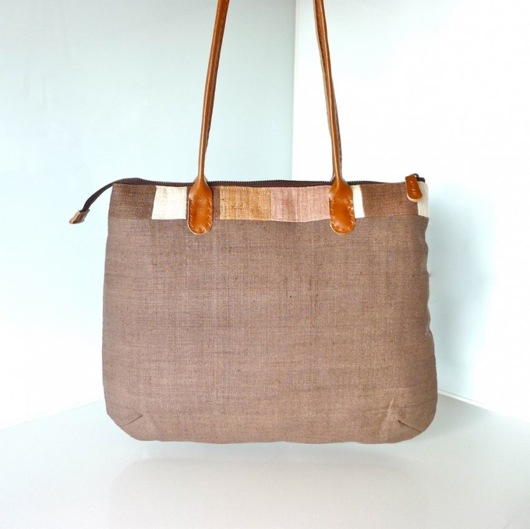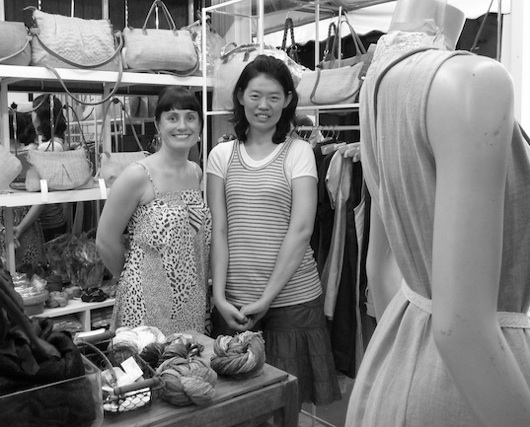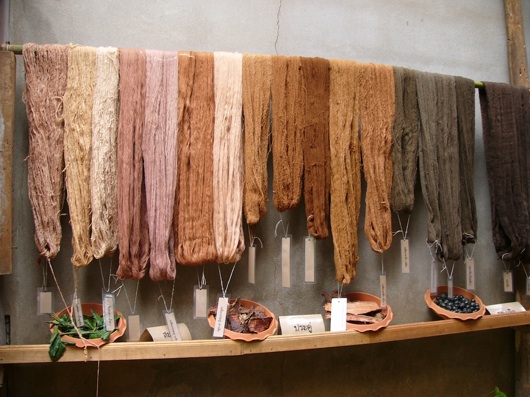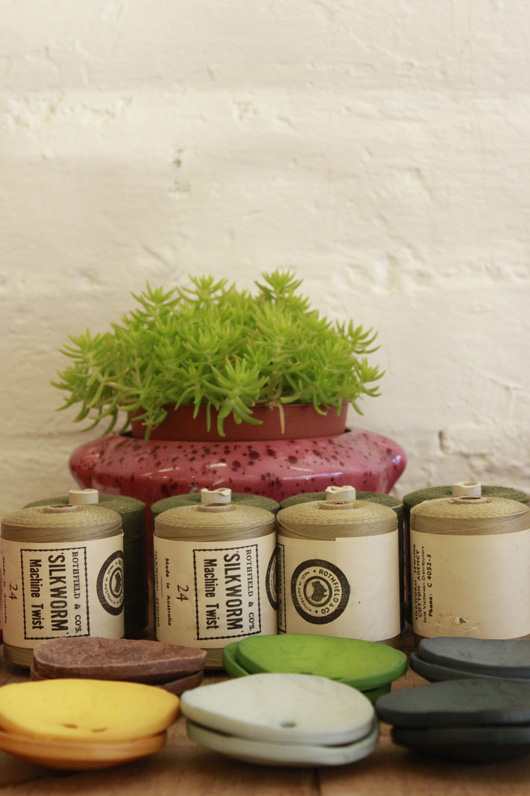Eco-Friendly Practice: Georgia McCorkill
By Phoebe Miller The pitfalls of fast fashion have rightly come under the spotlight in recent years, namely the effect on designers who struggle to compete with cheap product mass produced offshore and the impact on the environment. This month, we caught up with a local designer who's striving to make a positive impact with her work.
Georgia McCorkill's The Red Carpet Project is a design driven collaboration between designers, celebrities, stylists and publicists that uses the captivating properties of the fashion worn on the red carpet to raise awareness of environmental problems faced by the fashion industry. The project forms part of a PhD in Architecture and Design that Georgia is undertaking at RMIT University.
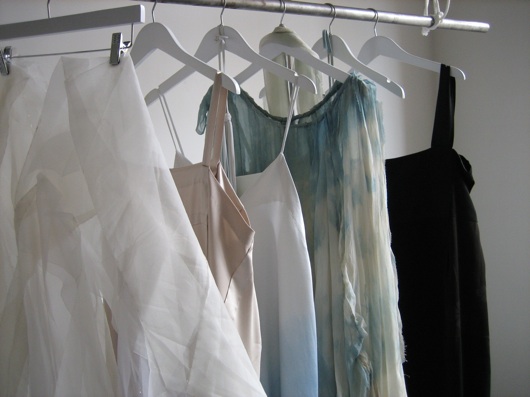 Garments featured in The Front Row Project at LMFF 2012
Garments featured in The Front Row Project at LMFF 2012
What do you do/ design/ make? I design special occasion dresses that are informed by principles of design for sustainability. I find situations where the dresses will come to public notice, be it a red carpet event, a wedding, the front row of a fashion parade or on the catwalk itself, and then I engage participants involved with these events such as actresses, publicists and the like in order to make a project happen.
The interesting thing about what I do is that my work attracts praise for making sustainable fashion appeal to a popular audience through its pleasing aesthetic, yet it’s not at this point a commercial endeavor, it’s a creative activist practice.
 Oscars dress design shortlisted for Suzy Amis Cameron’s Red Carpet Green Dress competition
Oscars dress design shortlisted for Suzy Amis Cameron’s Red Carpet Green Dress competition
How do you approach sustainability and environmental awareness in your creative practice? The starting point for my designs is the idea that a special occasion dress is often only worn once, therefore its requirements for durability are minimal.
Current approaches to design for sustainability tend to focus on employing a range of design strategies as appropriate to the situation, such as recycling, re-use, design for disassembly, etc. I pretty much work within this framework, and try to constantly evolve new iterations of these strategies that I think are more innovative and better than the last. For instance, earlier work has focused on the use of natural plant dyes as well as upcycling fabric remnants. I continue to do these things, but my latest work has been more focused around designing dresses so that they can be disassembled and re fitted, thus facilitating sharing between wearers.
 Fair@Square Fair Fashion Parade. Photography by Chealse Vo.
Fair@Square Fair Fashion Parade. Photography by Chealse Vo.
Can you tell me about one or two of your favourite projects that showcase this approach best? My most recent project was called “The Front Row”. I was interested in showcasing a model of fashion whereby the dresses can be shared, with the designer acting as a moderator and custodian.
The similarities between the celebrities who walk the red carpet and the fashion people who occupy the front row of the fashion parade inspired me to use the L’Oreal Melbourne Fashion Festival as a setting for the project. As part of the LMFF Cultural Program I created a range of dresses that were worn by people attending the fashion parades throughout the festival. The pieces were returned to me after wearing, and I made alterations such as dyeing or re-styling so that another person could wear the same piece again to a new event. I ran the project from a pop up studio space that was open to the public and it was a manic but really fun three weeks of activity.
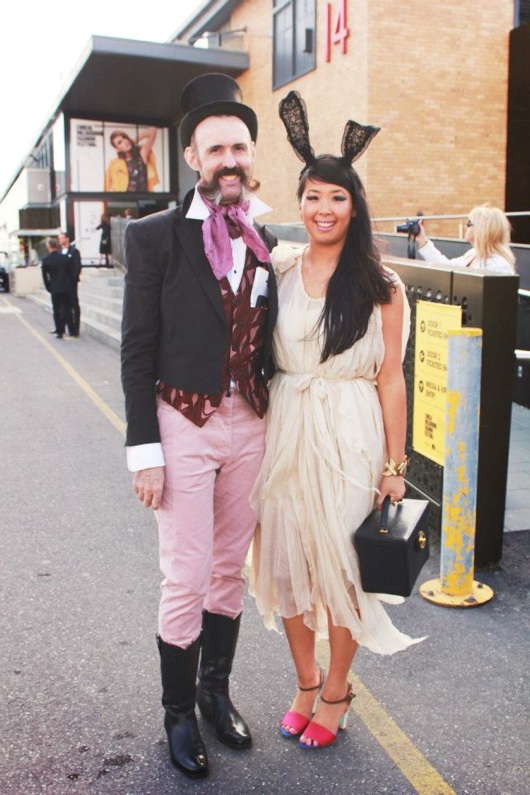 Lisa Teh from Couturing (right) a creations for The Front Row, with Richard Nylon
Image by Wanda Chin for Couturing
Lisa Teh from Couturing (right) a creations for The Front Row, with Richard Nylon
Image by Wanda Chin for Couturing
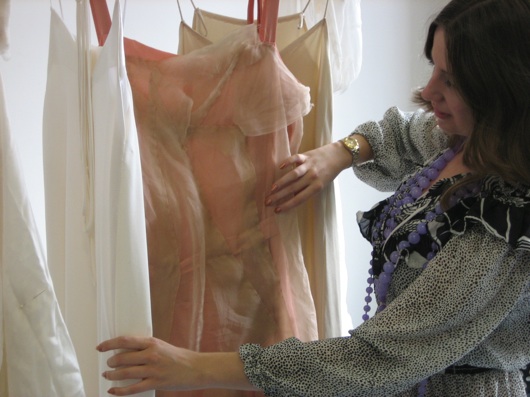 Lady Melbourne perusing Georgia's The Front Row collection
Lady Melbourne perusing Georgia's The Front Row collection
How and/ or where do you source your materials? I source remnants from bridal couture designers; the spaces that surround a pattern piece when it is cut out. These fabrics are of exceptional quality and ideal for processes such as dyeing. The odd shapes have come to determine many aspects of how I make the dresses, and I have developed a way of working with the remnant shapes in all their oddity without having to tame them too much.
Other fabrics might come from remnants from second hand kimonos, or fabric store remnants at the ends of rolls.
One issue when you talk about materials is that sustainability tends to focus on materials usage and issues such as recycling or organics. It’s a challenge to think beyond these things and imagine all of the other ways that fashion could be that embrace fashion not just as material production but as a symbolic cultural phenomenon.
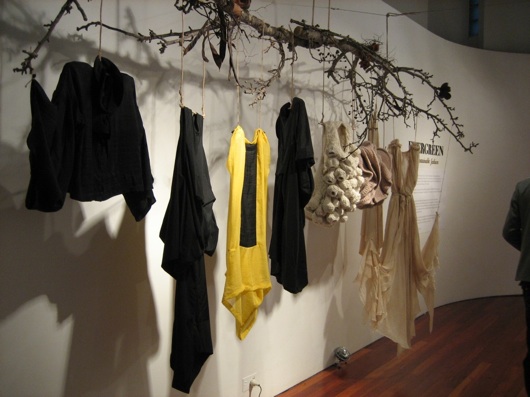 Evergreen: fresh sustainable fashion exhibition at Object
From left to right: Holly McQuillan, Julia Knupfer and Georgia McCorkill
Evergreen: fresh sustainable fashion exhibition at Object
From left to right: Holly McQuillan, Julia Knupfer and Georgia McCorkill
What challenges have you come up against in trying to make your practice sustainable and how did you overcome them? It wasn’t as though I had an unsustainable practice and then I tried to make it sustainable. It started with an idea of how I wanted this practice to be and then I worked towards that. The real world nature of the projects means that what you would ideally like to do is not always possible, because everyone involved has to be satisfied that my designs will fulfil the purpose they have imagined for it.
I’ve come to enjoy though exploring the possibilities for this more conciliatory approach to design, because ordinarily as a fashion designer you are encouraged to see yourself in a much more authoritarian role.
Is there anything you’d like to do or learn to further increase the environmental sustainability of your creative practice? My future aspirations are to continue to use design in a spirit of activism to encourage innovation in the ways we make, consume and relate to clothes and fashion.
 Cheryl Lin donning a piece from The Front Row collection for the Business Chic Little Black Dress Project
Cheryl Lin donning a piece from The Front Row collection for the Business Chic Little Black Dress Project
Who inspires you? I’m really inspired by anyone who is challenging fashion not just from and aesthetic perspective but from a systematic and cultural point of view.
All images in this post courtesy of Georgia McCorkill and The Red Carpet Project, unless otherwise noted.
Stress & Wellness: Winter Wellness
By Emily Harrison There’s a chill in the air that reminds us that Winter is well on the way, if not here already…
As the last of the Autumn leaves are being swept away it seems as though the round of early season colds and flus are sweeping through as fast as tissues boxes can be handed round.
I thought I was doing well – the centre of my own immunity – ‘til the defences slipped a little (note to re-read column on managing stress again) and I toppled like the rest of the crowd, face first into a box of tissues.
So a timely Winter Wellness piece for all our creative women out there to keep you thriving (or get you back on your feet) over the coming months.
I spoke with one lady you’ve probably heard of or seen in the media or perhaps you have read her books - Mim Beam is a naturopath with a wealth of experience in the realm of natural health. Mim has provided these two recipes to help keep your Winter a well one.
Mim’s tea to help prevent or recover from a cold or flu.
Ingredients:
- Handful of fresh thyme crushed up
- Juice of one lemon
- Rind of half a lemon, chopped
- Honey
- Ginger (around 1.5cm chopped)
- Cinnamon stick
Put all ingredients in a tea pot or a plunger with boiling water. Let it steep for around 5minutes and enjoy. Mim recommends having three cups a day of this delicious tea to help you get over a bug.
Mim’s cough remedy – can be used for the little ones too from six months onwards.
Ingredients
(Yes I was sceptical but read through to the end...)
- Chop up an onion – either red or brown
- Cover it with honey
- Leave for 4 hours
- Then take some of the syrup (it turns into a liquid and tastes quite nice, really, keep reading)

The verdict:
Well I think Mim could hear my scepticism…an onion…really? But I was curious. You see throughout the phone conversation I had been trying to keep back my own coughs and sniffles…nothing like talking to a health professional and saying you write a Wellness column (cough cough splutter splutter)… it’s up there with cleaning your house before the cleaner comes.
So off I went to cut up an onion – I used red because that was on hand, popped it in a bowl with the honey and waited. My doubts had to be put aside as I saw a lovely syrup that developed and well, it tasted quite nice too. Hurrah, and it was effective. It got the voice through an evening of teaching classes.
Mim explained onions have antiseptic properties (as does the honey) but the properties in the onion also help to break up mucous and congestion.
Hopefully you will all stay wonderfully well over the Winter and won’t need such remedies. Although the tea really is delicious and I’ll be making it throughout the cooler months.
If you do try the recipes I’d love to hear your thoughts or any other suggestions you have.
With thanks to Mim Beam from Beaming with Health for providing these natural remedy recipes.
Emily Harrison is a yoga teacher, writer and communications adviser with a passion for health and wellbeing. She encourages people to discover the vast potential and possibility that lies within each and every one of us. You can read more at iamem.com
Organise Me: Mumpreneur’s (Creative Mums)
By Andrea McArthur

It’s been a few months since I started this freelancing from home gig. I have come to the conclusion that I am well versed in design, however it’s everything else which is challenging; the quoting, the time management, the finding clients, the business side. Recently though, I had a realisation when I was at a friends house. She works for an Arts organisation and divides her time between the office and working from home with her kids and it was only then did I realise that I don’t have nearly as many distractions or time management stresses as working Mums. So with much respect, and considering that I don’t have children myself, I have interviewed a fellow freelancer who explains to me how she manages to juggle work and children.
The Stats: Studio: Duosista www.duosista.com.au Industry: Graphic and Web Design Title: Freelance multi-talented designer Name: Kylie Meller Location: Brisbane/Toowoomba Studio Location: Home (remotely for change of scene) Children: Two angels, Flynn (3yrs) & Summer (2yrs)
What inspired you to make the leap into working for yourself? Flexibility. The flexibility to manage my work and the kids in my own time. I wanted to be able to spend my days with them and was happy to work nights to do that, but working for a studio did not allow for that flexibility.
On average how many hours do you work? I would work 40-50 hours a week.
Do you have your children at home with you during working hours? If so how do you juggle both work and children? I did at first I had my kids at home with me when they were little, but once they started crawling I found it harder and harder to work. Originally I had a nanny two days a week to watch the kids while I worked, then when they reached 15 months we decided to send them off to daycare so they could share their time with other little people.
My biggest lesson I have learnt when working at home with kids is to be organised, work while they sleep and be prepared to work nights so that your days are free to be with your kids.
It is a constant juggling act, I have been able to over come that guilty feeling when you think you are not giving enough attention to one or the other. For me the other lesson that I have accepted over the years is that my kids are only home for such a short time (currently they are home for two working days a week), so when they are home with me, they take propriety over work every time.
I schedule emails to be sent the day after I have worked during the night and I make myself available for client phone calls each morning. After that time I use the answering machine and return phone calls at my convenience and when home noises are at a minimum.
What are a few things on your life to-do list? I am currently ticking off one of my life to-do list items and that is leaning to print with a letterpress. It has been an interest of mine for quite sometime and I finally made the leap this year to purchase my own. My other big goal is to move the family to France to live for a year or more, I’m am currently spending time working out ways to ensure my business can be carried on no matter where I am living.
Professional goals that you are currently working on? Restoring my 1950’s Heidelberg Windmill Platen Letterpress back to it’s former glory and having a range of stationery ready for Christmas.
Any special tips you have to stay organised throughout your week? Prioritise your work, ask people what there timelines are on projects and schedule your work to suit, keep a really good project/time keeping program to keep you on track and schedule certain days to do certain tasks.
Do you regularly talk to other freelancing mothers? Yes I sure do, and I would die without my network. I network closely with two other Mums (one has twins), we share our workload and look after each others clients when we are away on holidays or off looking after sick kids.
What do you wish you had known before you started freelancing with children? I wish I had worked out how to value my time better, I spent the first few years in my business just trying to work out how to quote my jobs. I wish I had spent more time when working in studios understanding their quoting processes so that I could better understand the value of design when heading out on my own.
I would like to thank Kylie who is a busy Mum and multi-talented designer all at the same time – working from home to enjoy more time with her children like many Australian women. Researching into the world of working mums has left me inspired and ready to get on top of my own time management issues.
To finish I have pulled together (with the help of other mothers) a few additional ideas for Mums balancing between running a business and children at home.
- Arrange work around your children’s sleeping patterns. (Work nights to leave your days free like Kylie). Sometimes this is not possible so plan activities, create a children’s office space beside you (get your children involved). Also pre-prepare tasty snacks to have on hand when you are on deadline.
- Use an answering machine instead of always picking up phone calls and return the important calls later. You could also use other communication platforms such as email or Messenger where your clients can’t hear any noise.
- Squeeze in quality work time before your family wakes up. Ouch, this one sounds tough, but my mother used to always tell me in order to actively get things done I needed to wake up at 5am.
Andrea McArthur has a passion for all things visual and a soft spot for organisation. Type is her true love and goes weak at the knees over beautiful design. Andrea works as a freelance graphic designer in Brisbane by day and lectures in graphic design by night. You will find her sharing design related goodness via @andyjane_mc www.andyjane.com
Book Review: The Handmade Marketplace by Kari Chapin
This little gem of a book is a handy 'how-to' on selling your handmade creations (whatever they may be) locally, globally and online. Written by a crafter (Kari Chapin), for crafters, it's full of great advice for turning your hobby into a business.
Divided into three parts, The Handmade Marketplace covers everything from goal setting, branding and pricing in Part 1 to marketing, blogging and publicity in the second part, with the last section focusing on selling: at craft fairs, online and in bricks and mortar stores.
Sometimes the specific business advice is not relevant outside the north American market but there's still plenty in there to sink your crafty teeth into. It includes helpful tips about all aspects of creative business from using social media to building community and, of course, selling your stuff. I especially like that it's full of advice from real people who have successfully turned their passion into a thriving business. People like Ashley Goldberg, Grace Bonney and Holly Becker (and many others) have been interviewed and snippets of their wisdom appears throughout the book.
It has also been illustrated by Emily Martin (aka The Black Apple) and Jen Skelley whose drawings give it a funky indie art feel. The fun design of the book and the conversational writing style means it's a breezy and engaging read.
If you're looking for inspiration to turn your crafty pastime into a business this book will have you brimming with ideas. It's a great starting point for taking your crafty ideas to the next level.
The Handmade Marketplace is published by Storey Publishing.
Jodi Wiley is an artist, writer, teacher and blogger. She has written freelance articles and book reviews for magazines and newspapers, as well as education curriculum. She has won awards for her artwork and been a finalist for several art and illustration prizes. Jodi is currently on maternity leave from high school teaching and is on a (quite frankly deranged) quest to update her blog daily: artbywiley.com
Women in the World: Tilburg
By Joanna Francis This month in "Women of the World", I wanted to learn more about what it takes to have a business which works collaboratively with women in developing countries to create and sell beautiful and ethically made products.
Recently I bought a gorgeous bag for my mum (that's her modelling it above!) and was fascinated by the story and ethics behind the label. Leanne Mutsaers is the woman behind Tilburg, a boutique fashion accessories purveyor based in Melbourne, and today she shares her story with us.
Can you tell us a little bit about the history and philosophy of Tilburg?
Tilburg’s story is woven with a rich tapestry of family history and years of memorable travel, which has inspired and unraveled this journey of passion to present beautifully designed pieces to consumers with a social and eco conscience.
Bags & accessories in the collection are individually handcrafted using talent and skill from artisans from around the globe and in Australia and feature natural materials such as hand woven hemp and organic cotton.
It’s all about moving away from mass production & appreciating well made products.
I had been an Art & Design teacher for a few years before I quit full time work – I was tired of teaching design and just wanted to do it myself! I knew it would be centered around handbags as I could never find one I liked and hated the ‘bling’ look. When I lived in London for a few years, I used to keep a book of future business ideas. This was one of them. Making the transition though has been endless hard work, sleepless nights and a lot of sacrifice and money. I have a lot of family members running their own business, so inevitably it was in my blood too. I didn’t want to be one of those people in 20 years saying “If only I had….” So I did.
What drew you to wanting to work with women artists in developing countries and how did you come to be working with these particular groups of women?
One particular trip to Thailand enabled me to have a light bulb moment – that’s where I met one of my current business partners. I came across her shop and products and fell in love with the artisan qualities and natural fibres still being used. That got me very excited and I made a decision there and then that I wanted to work as ethically and sustainably as possible – this was the direction I wanted to take with my business. Then I had to figure out how to get her onboard with me. This business relationship did not happen overnight, it took 2 years and many flights back and forth to develop trust, friendship and a business plan together. She utilises rural groups for hand woven fabrics, and employs local women to make the bags and work in her shops. They are all paid fairly and all of the women I have met at the shop just love their jobs!
How does the collaborative process work?
The collaborative process works in a few ways. My partner in Thailand creates the bags from start to finish. I have a hand in colours and styles that may work in Australia. We talk on skype often if I can’t get there and we are always talking about new designs, colours, fabrics and production issues. One of the biggest issues we face is that a thing like hand weaving is an art form that is being lost. Many of the young hilltribe people do not want to keep up the art and move to the cities. We are already thinking about what other options we have for fabrics and fibres.
I’m also currently working on 2 other collaborations with Australian artists, and we are feeling our way through that process. A meeting of minds, ideas and talent!
How does being involved improve the lives of the women who are working on these projects?
Being involved and taking an active interest allows the livelihoods of women in developing countries to quite simply earn a living. This may be through maintaining artisan skills in small villages that rely on this as their sole livelihood or working in a shop and learning English. Many of these women also get to make the bags in their own homes, which enable them to look after their family.
Tilburg also donates to charities from the communities I work from – helping women and children.
What are some of the challenges you have faced and lessons you've learned?
My biggest challenge is finding consumers with a conscience about what they are buying. I have watched many a customer pick up PVC bags thinking they were leather, buy a cheaper mass produced item over items made by an Australian business that are slightly dearer. I’d love to see consumers a bit more savvy about what they are buying. If you find something you love, spread the word! The other challenge is internet exposure and advertising. How do you compete with the big guns?!
Another hurdle has been learning how to deal with cultural differences. I work out of Indonesia and Thailand – both very different in the way they conduct business. At times completely frustrating, but the more I learn, the more patient I get. You just have to roll with the way they do things and work your business around that. Developing trust with business partners is a huge investment of travel and time. You just can’t do it over an email. The best relationships are formed in person.
Where can we find out more/ buy products/ assist?
My products are available online at www.tilburg.com.au
I only do small runs so if you see something you like, grab it! I am also stocking in small boutiques. You will not find Tilburg in a shopping centre. As I said earlier – if you find something you love become part of the tribe and spread the word. That’s the only way businesses such as Tilburg, with a different philosophy can make its mark and keep doing great things.
Joanna Francis spends most of her time hanging out with her one year old son. But she also works for a children’s foundation and has recently started her own little business making baby quilts. It goes without saying that her house is a mess. In the past, Joanna has worked as an aid worker in several developing countries, and is passionate about the rights of women and children. You can visit her and her blog at www.miettehandmade.com
Scenes From Sydney: Etsy Love
I am a huge fan of Etsy. I love to shop on Etsy, buy gifts, decorate my home, treat myself and secretly hope to someday have my own little Etsy store. It's an inspiring website and anyone who has seen photos of their US headquarters will see that it looks like a pretty inspiring place to work as well.
What's even better is that Etsy has recruited some local talent to head up their Australian operations and I was lucky enough to chat with Angela D'Alton about her new position.
1.) What is your background and explain what you were doing prior to Etsy? Prior to becoming the Australian Community Manager for Etsy I was the founder and director of Leeloo.com.au, an online store and blog dedicated to supporting and nurturing the talents of emerging designers and artists from Australia. I did that from 2007 until the beginning of this year. Before that I worked in various roles, including an extensive career in Information Technology, a fair bit of retail, a lot of administration and I was even a Massage Therapist/Reflexologist at one stage! My heart was always living in the world of creativity though, and I found it difficult to 'fit' in those worlds.
2.) How have you dealt with a change in careers and/or new direction? Very well! It was a conclusion drawn by myself and my husband that I was really not cut out for corporate life. I love working hard, however I needed to be able to commit myself to a job in which I believe in what I do every day, you know, a good reason to get out of bed. I've always been a believer in supporting artists and grass-roots communities, especially within our own country. Given the background that I had in customer service, and I.T., combined with my huge love of fashion and design, starting my own online store was a natural choice, a marriage of sorts between my technical corporate background, and my creative artistic passions.
3.) What advice would you give to other women thinking of change but might be hesitant? Start small, and make little changes every day that lead you towards your dream. It takes time, hard work and a lot of learning and listening. Don't start by taking huge risks. Maybe find a middle ground part-time job for a little while as you find your feet in your own business, but don't let the dream go. While it might seem scary, doing something you love is far more fulfilling than you can imagine. Staying positive can be difficult during times of knockbacks and the low energy days, but trust that you will bounce back and eventually find your routine, and the discipline that you need. The world doesn't owe you anything, you need to go after what you want. Most importantly, no-one will believe in what you're doing unless you believe in it.
4.) What's up next for you in your new role with Etsy? what advice can you pass along to Australian women thinking of joining Etsy? My new role at Etsy involves the support of the growing number of Australian people who have their own Etsy shops, whether they are designers, artists, vintage enthusiasts or supplies providers to the creative community. I'm planning events to inform and inspire, as well as being a point of contact for feedback to our head office in Brooklyn, providing the Australian perspective. If you are keen to join Etsy, I definitely recommend it. There's no community as kind as this one! Etsy provides sellers with a great deal of support, guidance and education. New tools are constantly being developed to ensure great experiences for all of our members. It's an affordable, easy and fun way to reach a large, global audience. Etsy gets over 40 billion unique visitors each month. There are also heaps of great resources available in the Seller Handbook section of Etsy's blog. Also, with the support of myself and my Melbourne-based counterpart Kirsteene Phelan, there will be lots of local happenings coming up. We're looking forward to a fun and exciting 2012! Visit etsy.com/sell to get started. Still want more? Make sure to check out Etsy Success Sydney as part of the Vivid Festival. I'll be back next month to report on the festival.
Originally from Boston, Massachusetts, Jaclyn Carlson is the author behind the Sydney-based blog, Little Paper Trees. When not documenting her expat adventures, she can be found working for one of Australia’s top design & homewares trade shows. Passionate and prone to wasting hours on Pinterest, she has years of experience in marketing, advertising and PR and aims to put Sydney’s creative women in the spotlight with her monthly column.
Tools of the Trade: Pauline Tran & Pop Craft
By Brianna Read For this fourth instalment I had the pleasure of interviewing Pauline Tran – the brains and heart behind Pop Craft. The second instalment of Pop Craft was recently launched in its temporary home at the craft hub that is Harvest Textiles - but more on that later.
I had an inkling that Pauline would make a fascinating interview subject for Tools of the Trade as she is a woman with many strings to her bow – I only hesitate to use the phrase ‘jack of all trades’ here as it implies a lack of mastery which simply does not apply!
When asked to pin down what exactly her trade is, Pauline is thoughtful for a second, then she quips ‘Do you mean what do I write on my immigration card?’. You see Pauline has a background in textiles (weaving, knitting, you name it), travel tour operation (textile tours in Vietnam, culinary and museum tours through France’s Basque country and tapestry tours in England and France) language teaching (French and ESL) and most recently as pop up shop organiser and patron saint of Melbourne makers.
So what does she write in the occupation field of her passenger card? Weaver! ‘Out of vanity!’ Pauline goes on to explain, but those who have seen her textile designs know that this is simply modesty.
And what tool is most prized by this very versatile woman? Her communication skills of course. She says she could not do what she loves without her ability to communicate her ideas to the many people she includes in her various projects. Pauline describes the experience of setting up and promoting the first Pop Craft to share her passion for beautifully crafted yarns and textiles with others as jumping in the deep end. She navigated this new territory deftly with the invaluable guidance of Emma Byrnes from the Harvest Textiles team and Pop Craft is back again.
This incarnation of Pop Craft features works by Ilka White, Stella Jones, Lotta Apted, Kayo Taguchi and Anna Varendorff to name a few. There are also workshops, knitting kits and delicious yarns galore.
Pauline also says she could not do what she does without her MacBook Air – she describes her laptop as an interface, a means to an end. The end being the sharing of her ideas - and the ideas of others that have inspired her - with an ever increasing audience. Spend an hour in Pauline’s company and you quickly realise she is just as at ease screen printing, knitting and enthusiastically talking with visitors to her wonderfully bright and inspiring pop up shop as she is quietly organising, co-ordinating and collaborating away on her laptop.
I love to ask creative people about the history of their preferred tool – the communication skills that Pauline spoke of are clearly a natural aptitude that she has recognised, put to use and developed, its history is constantly being written. Those folk who defy categorisation I like to call innovators, the wonderful skill Pauline regularly uses is her ability to find the right tool to bring her ideas into reality and I get the impression that if a tool she needed didn’t exist she would still find a way.
Pop Craft is at 512 Lygon St Brunswick East and opens from 11am-5.30pm.
Brianna Read is a designer-maker based in Melbourne. Her knitwear label Jack of Diamonds employs hand-made techniques in combination with machine knit technologies. Brianna’s multi-faceted creative practice encompasses design, production, works for exhibition and machine knitting workshops.





